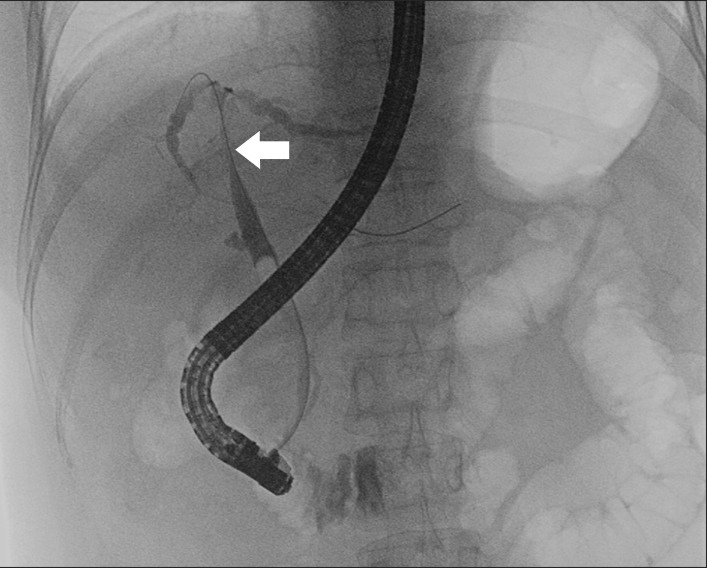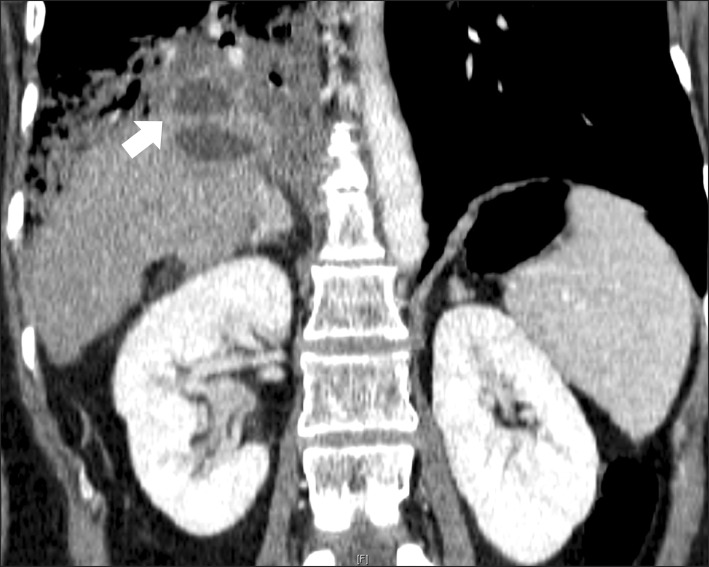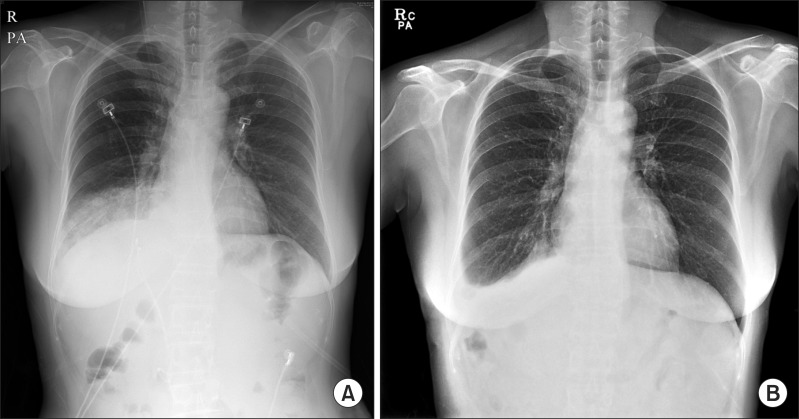Korean J Hepatobiliary Pancreat Surg.
2013 Aug;17(3):135-138. 10.14701/kjhbps.2013.17.3.135.
Surgical treatment of bronchobiliary fistula due to radiofrequency ablation for recurrent hepatocellular carcinoma
- Affiliations
-
- 1Department of Surgery, Samsung Medical Center, Sungkyunkwan University School of Medicine, Seoul, Korea. dwchoi@skku.edu
- KMID: 1472530
- DOI: http://doi.org/10.14701/kjhbps.2013.17.3.135
Abstract
- Bronchobiliary fistula (BBF) is a rare complication of radiofrequency ablation (RFA), in which there is abnormal communications between the biliary tract and the bronchial trees. Surgery should only be considered for BBF when non-invasive interventions have failed. In this report, we describe the surgical management for BBF when complicated by an abscess that was encountered after RFA in a 52-year-old woman with recurrent hepatocellular carcinoma (HCC). She had previously undergone central bisectionectomy of HCC 7 years ago, and had been treated with a sixth transarterial chemoembolization and first RFA for recurrent HCC after the operation. After the liver abscess and BBF occurred in the posterior section of the liver, she received posterior sectionectomy and hepaticojejunostomy, drainage of the lung abscess, diaphragmatic resection and repair because it was impossible to drain the abscess radiologically. Symptomatic improvements were being achieved through operative treatments where pleural effusion and pneumonic consolidation was obliterated on a 2-months follow-up image.
Keyword
MeSH Terms
Figure
Reference
-
1. Yilmaz U, Sahin B, Hilmioglu F, et al. Endoscopic treatment of bronchobiliary fistula: report on 11 cases. Hepatogastroenterology. 1996; 43:293–300. PMID: 8682482.2. Liao GQ, Wang H, Zhu GY, et al. Management of acquired bronchobiliary fistula: a systematic literature review of 68 cases published in 30 years. World J Gastroenterol. 2011; 17:3842–3849. PMID: 21987628.
Article3. Chua HK, Allen MS, Deschamps C, et al. Bronchobiliary fistula: principlesof management. Ann Thorac Surg. 2000; 70:1392–1394. PMID: 11081906.4. Peacock TB. Case in which hydatids were expectorated and one of suppuration of a hydatid cyst of the liver communicating with the lungs. Edinburgh Med Surg J. 1850; 74:33–46.5. Kim YS, Rhim H, Sung JH, et al. Bronchobiliary fistula after radiofrequency thermal ablation of hepatic tumor. J Vasc Interv Radiol. 2005; 16:407–410. PMID: 15758140.
Article6. Jung SI, Goo JM, Han JK, et al. Recurrent bronchobiliary fistula: unsuccessful management with repeated insertion of metallic biliary stent. J Vasc Interv Radiol. 2003; 14:1577–1579. PMID: 14654496.
Article7. Hibi T, Sakamoto Y, Asamura H, et al. Successful resection of hepatocellular carcinoma with bronchobiliary fistula caused by repeated transcatheter arterial embolizations: report of a case. Surg Today. 2007; 37:154–158. PMID: 17243037.
Article8. Pende V, Marchese M, Mutignani M, et al. Endoscopic management of biliopleural fistula and biloma after percutaneous radiofrequency ablation of liver metastasis. Gastrointest Endosc. 2007; 66:616–618. PMID: 17521647.
Article
- Full Text Links
- Actions
-
Cited
- CITED
-
- Close
- Share
- Similar articles
-
- Surgical Treatment of Bronchobiliary Fistula with Pulmonary Resection and Omentopexy
- Percutaneous Management of a Bronchobiliary Fistula after Radiofrequency Ablation in a Patient with Hepatocellular Carcinoma
- Biliary-duodenal Fistula Following Radiofrequency Ablation Therapy for Hepatocellular Carcinoma
- Biliary Fistula Developed after Radiofrequency Ablation Therapy for Hepatocellular Carcinoma
- Chemoembolization combined with radiofrequency ablation is the best option for the local treatment of early hepatocellular carcinoma?





